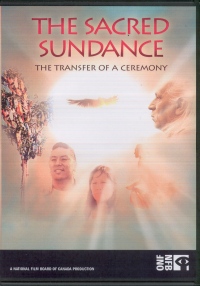| ________________
CM . . . . Volume XVII Number 7. . . .October 15, 2010. 
 |
The Sacred Sundance: The Transfer of a Ceremony.
Brian J. Francis (Writer & Director). Kent Martin (Producer).
Montreal, PQ: National Film Board of Canada, 2008.
69 min., 20 sec., DVD, $99.95.
Order Number: 153C 9108093.
Subject Headings:
Sundance.
Indians of North America-Religion.
Native peoples-Canada-Rites and ceremonies.
Spiritual healing.
Grades 11 and up / Ages 16 and up.
Review by Joanne Peters.
***/4
|
| |
|

excerpt:
The Sundance is an ancient ceremony that is now being practiced by the Mi’kmaq of the East Coast
It is a sacred ceremony that cannot be photographed – only experienced.
This film will not depict the actual Sundance but instead will explore the teachings of this complex and profound ritual.
If you have heard of the Sundance ceremony, you probably associate it with the Plains tribes of western Canada and the United States: the Blood, Sioux, Lakota, and so on. Although integral to the spiritual practice of these western tribal nations, the Sundance was outlawed by both the Canadian and US governments who saw it as “barbaric” and horrifying. One can speculate, from a more liberal, twenty-first century perspective, that if nineteenth century officials and law-makers had a sense of the many ways in which its sacred nature shares connections with many other great world religions, perhaps they might have been a bit more tolerant. Probably not – theirs was not a tolerant era.
So how does the age-old Sundance ceremony come to Elsipogtog, New Brunswick? In 1982, William Nevins, a Mi’kmaq Chief, found himself with a very sick child and desperate for hope and healing. His was “a quest for medicine,” and with his prayers for the healing of his son answered, he then committed to spiritual healing and to dance the Sundance. Thus, in the 1980’s, the formerly outlawed ceremony began to be restored. But, not only was it seen as a means of healing the body – Nevins saw that reclamation of the ceremony, along with an understanding of its spiritual nature and its potential to engender pride in heritage and culture, could lead to mental, emotional, and social healing of his community. A number of Sundance participants speak of their pasts, and of their experiences of abuse, substance addiction, and gang involvement. The mental and physical preparation necessary for a dancer to survive the rigors of hours of dancing under a hot sunny sky forces an individual to challenge him or herself.
Certainly, participation in the Sundance is not for the weak of spirit or body: participants undergo a series of four-day fasts, deprived of food and water, dancing in the hot sun, scarring their bodies through piercing of their own flesh which is offered to the Creator. But, what began as an initiation-into-manhood ritual for young boys becomes more inclusive in the 21st century. Women now participate in the dance if they wish, although many choose to limit their participation to support for the men who dance. It is clear, though, that female participants who choose this role do not view it as subordinate, but rather as a partnership. In the course of the film, the viewer is provided with an overview of important aspects of the ceremony, many of which are prefaced by black and white stills of nineteenth century, archival photos. We learn of the role of the buffalo, a sacred animal which provided all necessities of life for Plains tribes; the importance of tobacco, offered to the Creator, as it burns heavenward in pipes and other vessels; the selection and choice of “a tree of life,” bedecked with prayer ties (tobacco and prayers wrapped in small bundles of red cloth) and standing tall over the dancers and the ceremony site; and the four gates to the dance enclosure (along with a description of the significance of the coloured flags which fly over each entrance). Throughout, various chiefs and elders who lead the ceremony explain the significant spiritual dimensions of the Sundance; it is rich and profound in meaning, a ceremony in which “the sun shines on all,” and is described by one woman as “interfaith” because the sun shines on all people. Although the sacred mystery of the ceremony is maintained, close to the film’s conclusion, we do see a young drummer, his skin scarred by the piercing. And the tradition will continue to move and be transferred: throughout the film, we see young people running a relay, carrying a sacred staff which they pass along to the next runner on the road. The Sacred Sundance concludes with the commitment to a transfer of a Ceremony as a group of participants run into the Province of Quebec to carry the tradition forward to other tribal groups.
The Sacred Sundance is a useful resource for senior high school Aboriginal Studies courses, although teachers would have to provide a context for the ceremony, both in its historical sense and as a means for twenty-first century reclamation of a proud spiritual tradition. As well, teachers planning to use the film will want to preview it before showing it, particularly if they want to leave time for discussion. At almost 70 minutes of running time, it is slow-paced, with considerable discussion about the ceremony’s spiritual dimensions. Although this commentary is integral to understanding of the ceremony’s significance, not all students will find it as engaging as the beautifully photographed footage of the individual and community preparations for the Sundance itself.
Recommended.
Recently retired, Joanne Peters was a high school teacher-librarian in Winnipeg, MB.

To comment on this title or this review, send mail to
cm@umanitoba.ca.
Copyright © the Manitoba Library Association. Reproduction for personal use is permitted only if this copyright notice is maintained. Any other reproduction is prohibited without permission.
NEXT REVIEW |
TABLE OF CONTENTS FOR THIS ISSUE- October 15, 2010.
AUTHORS |
TITLES |
MEDIA REVIEWS |
PROFILES |
BACK ISSUES |
SEARCH |
CMARCHIVE |
HOME |
